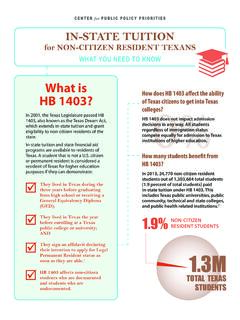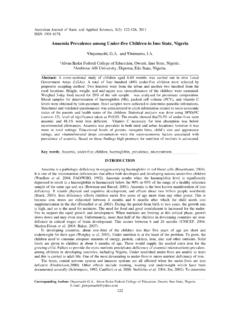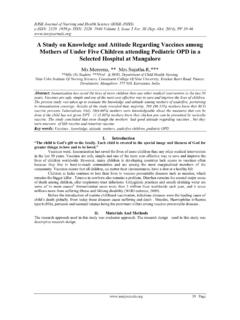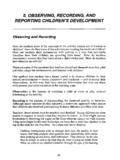Transcription of One in five Texas children lives in poverty, and state and ...
1 7020 Easy Wind Drive, Suite 200 Austin, TX T F November 15, 2018 Contacts: Amanda Gonz lez, Center for Public Policy Priorities, 956-283-6057 Jessica Mu oz, Methodist Healthcare Ministries, 210-546-2992 One in five Texas children lives in poverty, and state and local policies don t do enough to support the success of every Texas kid New state of Texas children report from the Center for Public Policy Priorities provides data and policy solutions to state leaders ahead of the 2019 legislative session SAN ANTONIO -- Large disparities in child poverty across race.
2 Ethnicity and gender persist in Texas due to historical and current discriminatory policies, according to the state of Texas children report released by the Center for Public Policy Priorities here today. As state lawmakers prepare to gather in January for the 2019 legislative session, they should keep Texas ' one in five children living in poverty at the top of their minds when they are making decisions during the upcoming legislative session. The report lays out the challenges Texas children and families face and also some common-sense policy solutions for state leaders to consider.
3 Read the report here. Detailed data are available for every county in Texas . Please contact or visit for localized child well-being data. "Our dynamic, growing, vivacious state of Texas can often be a terrific place for kids. But short-sighted public policies and inadequate investment have created potholes and detours that are keeping far too many Texas children from reaching their full potential," said Ann Beeson, CEO of the Center for Public Policy Priorities. "With the upcoming Texas legislative session, our state leaders have an important opportunity to let all children s well-being drive their policy choices and make Texas the best state for kids.
4 " CPPP released state of Texas children at a briefing this morning in San Antonio co-hosted with Methodist Healthcare Ministries of South Texas , Inc. Over 250 advocates, service providers, public officials and concerned Texans attended the event, which also featured a policy discussion with state Representative Diego Bernal, CPPP Legislative and Policy Director Luis Figueroa and journalist Bekah McNeel. Jaime Wesolowski, president and CEO at Methodist Healthcare Ministries, opened the event by reminding the audience that Texas consistently ranked in the bottom ten states for child-wellbeing.
5 "We all want to ensure Texas kids are on the path to a bright future, but Texas decision makers must create policies that improve conditions for all Texas kids and put them on the road to success." View a video of today's launch event here. CPPP and The Boone Family Foundation will hold another state of Texas children briefing in Dallas on December 4, 2018. Details and RSVP here. Key report findings include: An accurate 2020 Census count is essential for counting Texas diverse and growing child population.
6 Texas is home to nearly million children . Nearly half are Hispanic or Latino, 32 percent are White, 12 percent are Black, four percent are Asian, and three percent are multiracial or another race. Thirty percent of children under the age of five (about 582,000 children ) live in hard-to-count communities and are at especially high risk of being missed in the 2020 Census. Texas families financial security is too often associated with unequal opportunities across race, ethnicity, and gender. One in five Texas children lives in poverty, and Black and Hispanic children are disproportionately likely to live below the poverty line.
7 Poverty rates for families with children headed by single-mothers (38 percent) are twice as high as they are for families with children headed by single-fathers (19 percent). Access to health insurance has increased for Texas children , but too many kids still lack the health care, nutrition, and safety they need. Health insurance rates have improved since the passage of the Affordable Care Act, but 671,000 Texas kids remain uninsured, and significant barriers to health insurance coverage for Hispanic children persist.
8 Public health insurance programs cover 45 percent of all Texas children . One in four Texas children has experienced two or more "Adverse Childhood Experiences" such as physical or emotional abuse or separation from a parent. Inequities in school funding perpetuate achievement gaps. Cuts to the Texas public education budget have led to a decrease in per-student spending at schools with a high percentage of low-income students. Compared to 2008, Texas spends 21 percent less per student on programs to keep kids on track and 40 percent less per student on bilingual education (inflation adjusted).
9 The majority of school funding now comes from local property taxes, leaving students in districts with the lowest property wealth disproportionately students of color at a significant disadvantage in resources and outcomes. Key policy recommendations include: Consider all Texas kids when crafting policies, and promote a fair and accurate 2020 Census that counts every child living in Texas . Implement policies to ensure sufficient wages and benefits for workers to meet their families needs. Protect and expand comprehensive and affordable health insurance coverage.
10 Remodel Texas school finance system equitably fund schools and to meet the needs of every Texas student. ### state of Texas children is part of the Kids Count project, a national and state -by- state effort to track the status of children in the funded by the Annie E. Casey Foundation. Check out the Kids Count Data Center for extensive child well-being data for each of Texas 254 counties and seven largest metropolitan areas. This research was funded by the Annie E. Casey Foundation, Methodist Healthcare Ministries of South Texas , Inc.










